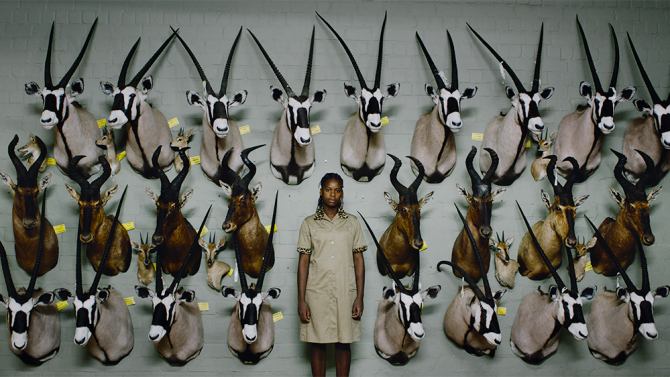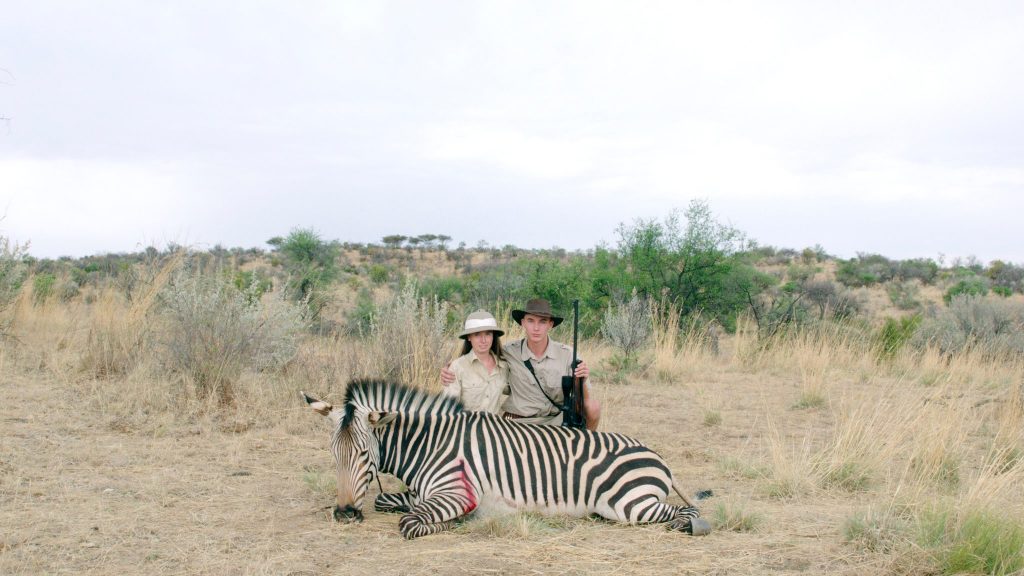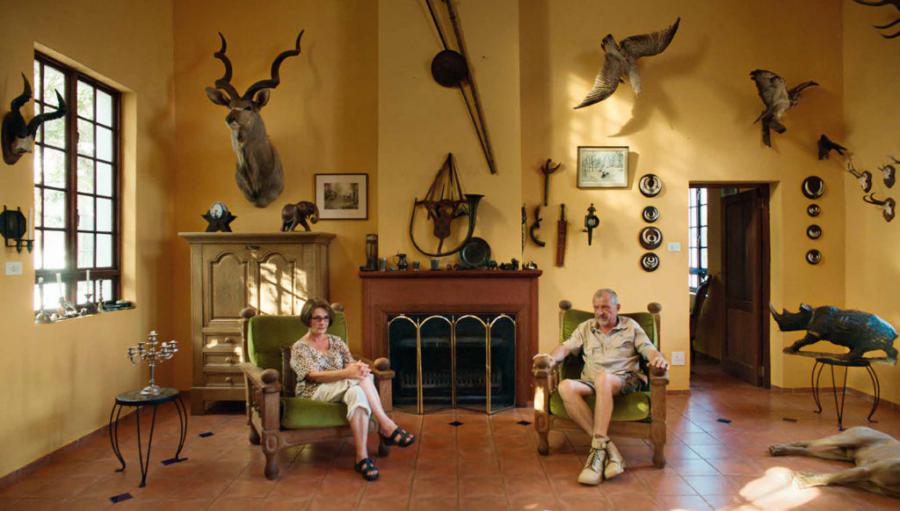What is the image that comes up in your mind when you think of safari hunters? A white man with a large gun standing next to a fallen beast? Maybe they’re dressed in camouflage with a smile on their face. The sight of them may twist your stomach and cause your palms to sweat. Odds are if you’re an animal lover, you’ve probably signed an online petition or two demanding the cessation of hunting reserves and have used Walter Palmer’s name as a curse word. Director Ulrich Seidl’s documentary, Safari, asks you to set aside these thoughts and simply observe safari hunters.
Objective documentary filmmaking is a difficult art to create. When Kevin Carter took a dark, terrifying photograph of a starving toddler and a looming vulture, he brought a desperate and painful situation to a wider audience. The toll that picture had on Carter was insurmountable and he eventually took his own life. To suggest a deep comparison between Seidl’s documentary and the painful stories that Kevin Carter’s photographs tell, is a tenuous one. It is, though, a necessary comparison, in that as documentarians sometimes photographers and filmmakers have to endure painful circumstances to enlighten the world about a subject. For Carter, it was the horrific situation in Sudan. For Seidl, it’s commercial hunting that runs in Africa.
Seidl focuses his camera on German and Austrian tourists who have journeyed to Africa to capture a prized animal of some kind. Wolfgang Thaler’s stunning cinematography keeps the subjects in the centre of the frame, as if he were lining them up with his crosshairs and steadying the camera for a pure, fatal shot. Whether it be the sleeping hunters in a high hide enclosure who startle themselves through snoring, or the wife who stays at the bungalow to sunbathe with a magazine over her face, or the various direct to camera interviews – Thaler’s camera is an all seeing, all assuming eye. This is cinematography that observes all, providing a chance for an objective assessment of the subjects.

Depending on your social media feed, you may have become either depressed or exhausted by the continuous drip feed of Ricky Gervais-esque hunter shaming posts, most of which focus on American hunters. In an interview prior to the films release, Seidl mentioned how he was inspired to tell this story after meeting an Austrian couple who had a basement full of hunting trophies in his 2014 documentary, In the Basement. In some regard it’s fortuitous that Seidl decided to focus on European hunters, rather than having American subjects, providing a different, less jingoistic take on what it means to be a hunter. The European hunter narrative is one that is often overshadowed by that of their American brethren, so to have Safari glimpse in to what drives these hunters to kill is fascinating and oddly refreshing. (It is worth noting though that after the screening that I attended, I had a short discussion with an audience goer who found the actions of the European subjects to be ‘very atypical’ of who they were – take that for what you will.)
Safari is at its most engaging when it opts to explore our own humanity when it comes to taking the lives of others. In an early sequence, a married couple sit and talk about the prices of various creatures – how many euro’s a gnu cost, what the value of an antelope is – their focus seemingly more intent on flicking through a price list in their mind. Later, we see the husband falling asleep in his hunting enclosure, the heat and beer having finally taken its toll. Elsewhere, the camera focuses on a family who has travelled to Africa to bag various different animals. In a discussion with two of the younger members, they run through what animals they would like to hunt and their reasoning behind wanting to hunt them. There is a genuine belief in conservation and a profound respect for the animals whose lives they will eventually take.
It’s through these discussions that the power and brilliance of Ulrich Seidl’s unassuming direction becomes apparent. By simply presenting his subjects and their actions with all the patience and silence that comes with hunting in-tact, it then falls down to the viewer to establish the final judgement of what is going on. For many – myself included – it will be easy to enter Safari with preconceived opinions, with the goal of having watched the film to simply have those opinions confirmed. ‘Hunters are bad, they have no soul, and therefore they should burn in hell’. And with sequences like a giraffe hunt (and the subsequent evisceration of the giraffe), it’s very easy to walk away with those opinions having been reinforced. Seidl is not aiming to change or alter minds with this documentary, he is simply allowing these characters to stand on their platform and discuss why they do what they do.

Discussions do run abound here, with Thaler’s camera providing the opportunity for the subjects to stare directly at the audience, almost as if they are questioning us and saying, this is who we were, whether it be hunter or helper, this is who we are as people. There is a clear, profound respect from all the hunters for the animals whose lives they are bound to take, with a clear understanding of the value of apex predators. That is not to say that the animals that are bagged don’t carry an emotional weight when their lives are taken.
While tracking a family of giraffes, the hunter pack is fuelled by anxiety and adrenaline of wanting to make the kill as clean and quick as possible. Scouts line up the animal with their binoculars, readying the shot for the hunter, and through silent motions they note when it is safe to take the shot. Commendations about the shot being ‘a good sketch’ (a true shot) run through the group in a murmur. Upon walking up to the giraffe, the family see that even though it is a fatal shot, the giraffe is still a ways from actually dying. It struggles to get up and lift its head, while a member of the hunting pack notes that the remaining giraffe family simply stands and watches this occur. Once the giraffe has died, the trophy photo parade quickly takes place, with the tour guide sticking some grass in the giraffes mouth almost as a show of respect to the animal. The remaining members of the hunting family arrive to assess the specimen, noting the battle scars that the aged male giraffe has that line his back.
(The placement of the grass in the dead giraffes mouth is an abject contradiction to the killing of the animal. Paired with an earlier action where a guide throws dirt over a zebras wound to cover the bullet hole, this grass placement seems to suggest a feeling of shame over having taken the life of another animal. It suggests the notion that if one were to photoshop the rifle out of the photo, that these khaki draped people had simply stumbled upon the dead body of a creature while taking a peaceful stroll in the savannah.)

A ute comes along and winches the carcass onto the back, tying the extended neck of the giraffe up so it doesn’t drag along the ground. Seidl cuts to the animal being offloaded into the cleaning room where through an extended sequence we observe the quiet and solemn evisceration of the giraffe. It’s a difficult sequence to watch, but the breaking down of the giraffes body is never sensationalised – it is simply presented in a very clinical fashion. Through death we are all reborn, and this is made all the more clearer within Safari with tableaus of people standing in front of walls of their hunting trophies. Where a giraffe or a zebra once wandered the sweeping vistas of Africa, they now continue on as empty, all seeing vessels that litter the walls of homes around the world. Just like Seidl’s subjects, they too stare at us and their slayers without judgement, almost as if to say ‘this is what you have made of us, this is who we have become due to your actions’.
The hunters are continually eager to distance their actions from that of the ‘thoughtless’ slaughter of animals in abattoirs for food. The change of the term ‘kill’ to the term ‘bag’ is utilised to help distance their actions of violence from the connotations that the word kill conjures up. It’s a notable distinction, as it becomes unavoidable to not have the thought of a blood thirsty hunter scouring the wilderness for that last remaining elephant calf, readying himself to kill the calf and slaughter it for his mantle. Seidl’s subject ensure that we, as viewers, understand the difference between ‘those people’ and who they are as hunters. They are eager to remind us, that even after seeing a giraffe fall, that they are people who can also show sympathy and love for animals. By removing inflammatory and reactionary language, the viewer is left to question their own stance on these subjects. Do they become enraged and have their perspective reinforced, or do they become more understanding of the human condition?
The core footage is devoid of any music, providing an unsentimental sense of calm that allows the quiet vastness of the plains to be experienced just how the hunters would experience it. The only presence of music is from the bookends of horns being blown, the brassy chant being trumpeted across a field. The horns blow almost as a reminder of the history of hunting, where a horn would blow to initiate a hunt or to sound the alarm of potential prey. Paired with Wolfgang Thaler’s camera, the horn feels as if it’s there to initiate Seidl’s quiet, measured tracking and subsequent bagging of his subjects.

The perspective that Ulrich Seidl has opted to showcase here is predominantly a white perspective, with the support provided to the hunters being that of black African helpers. He does provide a mostly wordless representation of their experience, by showcasing their efforts to assist the hunters in their goals, and through static shots of them in their downtime, consuming the aged meat of the animals that are killed. While some may take issue with the near silencing of the POC perspective, for me I found it simply worked to further the objective narrative that is presented of the hunters; as if adding another voice that isn’t that of the hunter characters would simply dilute their story.
Some may ask what value there is in watching ninety minutes on a widely derided subject such as hunting, and in the closing moments, the game park owner appears to answer that question. Raising the topic of the proliferation of the human race, the park owner suggests that ‘nature is gone’, that there is no longer a genuine ‘nature’ or real ‘wild’. Instead, each instance of nature is one that has been manufactured and corralled into being what humans feel represents ‘nature’. He almost suggests that hunting is the natural endpoint for the human races bacteriaesque domination of this planet we call Earth. Surrounded by trophies, he asks, ‘why should I justify myself? He asks these questions with an affectation that suggests that once all the animals are gone, that it will fall to mankind, with empty hands, to answer to its creator and finally atone for their actions. ’ If what he says is true – that by the almost ouroboros like way that humankind is bringing itself closer to extinction by hastening the extinction of other animals – then who are we to judge someone profiting off the death of mankind and the world around it?
While Seidl is not directly suggesting it himself, it is hard to deny the vague feeling that even if we have not killed an animal ourselves, we are still complicit in these actions. Simply through our existence at the top of the food chain, we are subsequently doomed to be condemned throughout eternity. Safari is most certainly not a documentary for everybody. While not ‘in your face’ with blood, guts and gore, Safari does raise a lot of questions. Most importantly, Seidl’s direction appears to request that even if you do not agree with the actions of his subjects, that you at least see how the world appears from their point of view. Seidl’s work has often challenged and provoked emotions that many directors would not be keen to even attempt to do draw out of people. In this regard, by documenting mankind’s domination over the animal kingdom, one has to wonder whether Seidl will have his Kevin Carter moment of questioning his place within the images of what he has captured. Where Carter saw atrocities and wished he could do more, will Seidl look back on Safari and question his documentation of these events?
Director: Ulrich Seidl
Writer: Veronika Franz, Ulrich Seidl
Cinematography: Wolfgang Thaler


